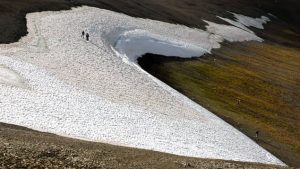Canadian archaeologists are surveying high alpine pastures in the Selwyn and Mackenzie Mountains of the Northwest Territories (Canada) in search for archaeological sites revealed by melting ice.

As each warmer summer peels off another layer of snow and ice artefacts lost or misplaced by prehistoric hunters who hunted caribou on mountain ice patches emerge. Archaeologists from the Prince of Wales Northern Heritage Centre in Yellowknife struggle to collect, study and preserve them before they decay. Among the artefacts are darts, bows and arrows

The surveyed areas are located at an elevation between 1500 and 2100 metres along the Rocky Mountain chain, near the Yukon-Northwest Territories border. Thousands of years ago hunters camped here for caribou which climbed high up into the high alpine to bed down at these ice patches to cool off and find some relief from the insects. At the top of a mountain the caribou were within the effective range of dart throwing and more bow and arrow technology. In the process they sometimes dropped or misplaced hunting implements – darts and throwing sticks, bows and arrows, and even snares.

Such artefacts were found in neighbouring Yukon since 1990s and now archaeologists record similar sites in the Northwest Territories, where mountainous territory encompasses 144000 square kilometres. Archaeologists used satellite data analysis to find the remnants of these ice patches to identify areas for the survey. The oldest artefact found by researchers was a piece of birch dart, being about 6000 years old. Researchers learned how ancient hunters chose certain kinds of raw materials for their tools and how that knowledge is still embedded in the traditional knowledge of Indigenous people. Moreover, data from the ice patches and the analysis of pollen records contained in caribou dung has shown that for the last 5000-6,000 years the environment in the area had remained relatively stable, but recently some ice patches melted out in over the period of five years revealing the dramatic impact of current climate change.
(after Radio Canada International & Tom Andrews)